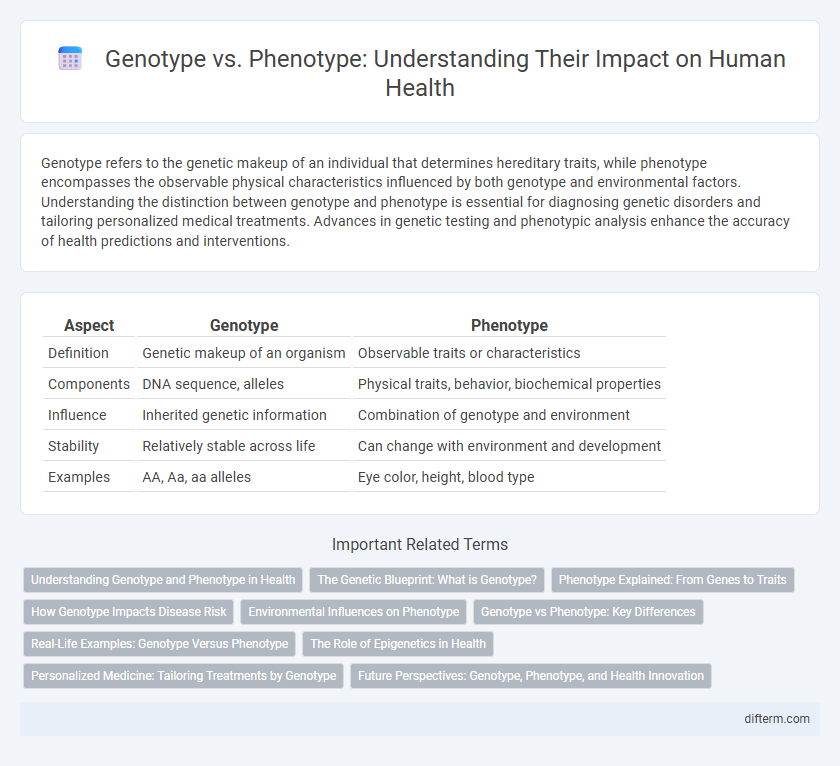Genotype refers to the genetic makeup of an individual that determines hereditary traits, while phenotype encompasses the observable physical characteristics influenced by both genotype and environmental factors. Understanding the distinction between genotype and phenotype is essential for diagnosing genetic disorders and tailoring personalized medical treatments. Advances in genetic testing and phenotypic analysis enhance the accuracy of health predictions and interventions.
Table of Comparison
| Aspect | Genotype | Phenotype |
|---|---|---|
| Definition | Genetic makeup of an organism | Observable traits or characteristics |
| Components | DNA sequence, alleles | Physical traits, behavior, biochemical properties |
| Influence | Inherited genetic information | Combination of genotype and environment |
| Stability | Relatively stable across life | Can change with environment and development |
| Examples | AA, Aa, aa alleles | Eye color, height, blood type |
Understanding Genotype and Phenotype in Health
Understanding genotype and phenotype in health is crucial for personalized medicine and disease prevention. Genotype refers to an individual's complete set of genetic information, influencing traits and susceptibility to certain conditions, while phenotype encompasses observable characteristics resulting from the interaction of genotype and environmental factors. Analyzing both genotype and phenotype enables precise diagnosis, targeted treatments, and improved management of hereditary diseases and multifactorial health conditions.
The Genetic Blueprint: What is Genotype?
Genotype refers to the unique genetic makeup of an individual, consisting of specific alleles inherited from both parents that determine potential traits and health predispositions. This genetic blueprint influences cellular processes and can predict susceptibility to certain diseases or conditions through variations in DNA sequences. Understanding genotype helps in personalized medicine by enabling targeted treatments based on individual genetic profiles.
Phenotype Explained: From Genes to Traits
Phenotype refers to the observable physical and biochemical characteristics of an organism, resulting from the interaction of its genotype with the environment. Traits such as eye color, height, and blood type serve as examples of how genetic information is expressed in a measurable form. Understanding phenotype enables researchers to link specific genetic sequences to tangible attributes and health outcomes, improving precision medicine and personalized healthcare.
How Genotype Impacts Disease Risk
Genotype directly influences disease risk by determining the specific genetic variants an individual carries, which can predispose them to inherited conditions like cystic fibrosis or sickle cell anemia. Genetic mutations or polymorphisms in key genes impact biological pathways, altering susceptibility to complex diseases such as diabetes, cancer, and cardiovascular disorders. Understanding genotype allows for personalized medicine approaches, enabling targeted prevention, early detection, and tailored treatment strategies based on an individual's unique genetic makeup.
Environmental Influences on Phenotype
Phenotype is profoundly shaped by environmental factors such as diet, climate, and exposure to toxins, which can alter gene expression without changing the underlying genotype. Epigenetic mechanisms, including DNA methylation and histone modification, mediate these environmental influences, leading to variations in traits like height, skin color, and disease susceptibility. Understanding the interaction between genotype and environmental influences on phenotype is crucial for personalized medicine and predicting health outcomes.
Genotype vs Phenotype: Key Differences
Genotype refers to the genetic makeup of an organism, encompassing all inherited DNA sequences that determine potential traits, while phenotype represents the observable characteristics influenced by both genotype and environmental factors. Key differences include genotype being the underlying genetic code, which remains constant throughout life, whereas phenotype can change due to external influences like diet, climate, and lifestyle. Understanding the distinction between genotype and phenotype is crucial for studying genetic disorders, personalized medicine, and trait inheritance.
Real-Life Examples: Genotype Versus Phenotype
Genotype refers to the genetic makeup of an individual, while phenotype encompasses the observable traits resulting from the interaction of genotype and environment. For example, identical twins share the same genotype but may have differing phenotypes due to environmental influences like diet or exposure to toxins. Another real-life illustration includes sickle cell anemia, where individuals with the same genotype can exhibit varying severity of symptoms depending on factors such as hydration and altitude.
The Role of Epigenetics in Health
Epigenetics influences health by regulating gene expression without altering the underlying genotype, thereby shaping the phenotype through environmental interactions. DNA methylation and histone modification are key epigenetic mechanisms that impact cellular function and disease susceptibility. Understanding these processes provides insights into personalized medicine and the prevention of complex conditions such as cancer, diabetes, and cardiovascular diseases.
Personalized Medicine: Tailoring Treatments by Genotype
Personalized medicine leverages genotype analysis to tailor treatments based on individual genetic profiles, improving drug efficacy and minimizing adverse reactions. Phenotype, influenced by both genotype and environment, provides observable traits that guide clinical decisions alongside genetic data. Understanding the interplay between genotype and phenotype enables precision therapies targeting specific molecular pathways for optimal health outcomes.
Future Perspectives: Genotype, Phenotype, and Health Innovation
Advancements in genomic sequencing and phenotypic data integration are propelling personalized medicine towards unprecedented precision. The convergence of genotype analysis with real-time phenotypic monitoring through wearable technology enables early disease detection and tailored therapeutic interventions. Future health innovations will increasingly rely on machine learning algorithms to interpret complex genotype-phenotype correlations, optimizing patient outcomes and preventive strategies.
Genotype vs Phenotype Infographic

 difterm.com
difterm.com